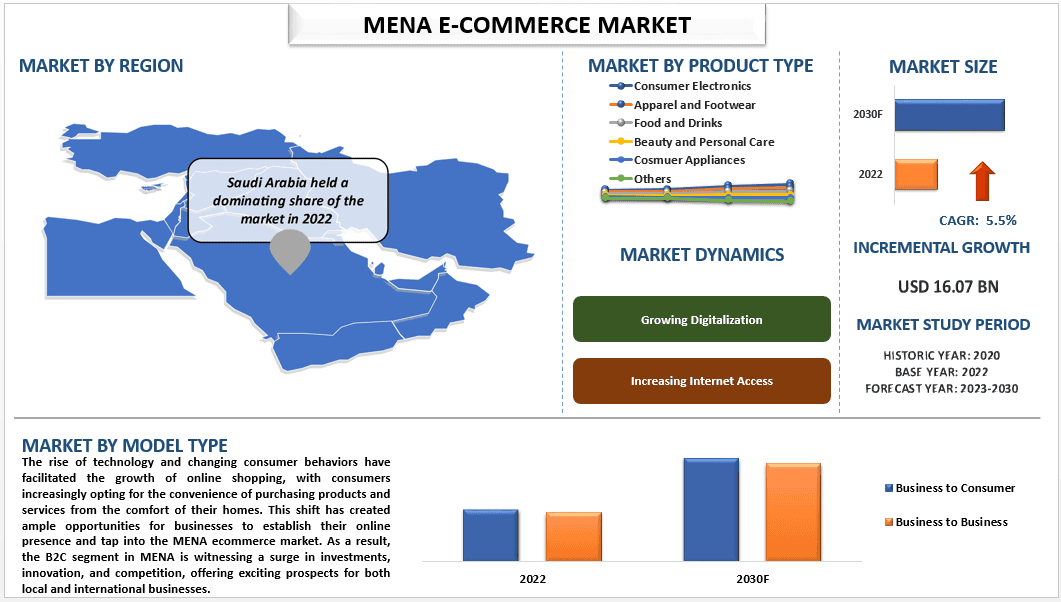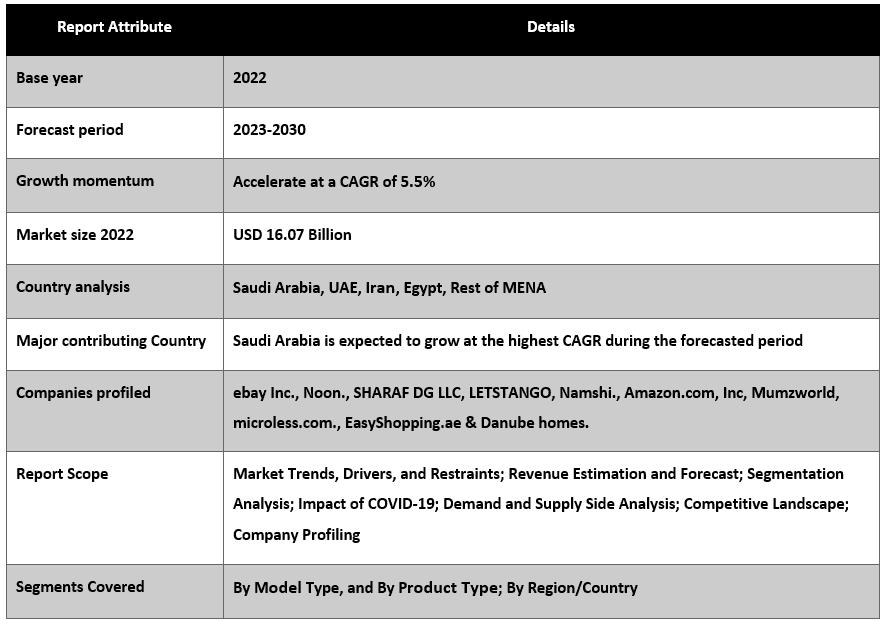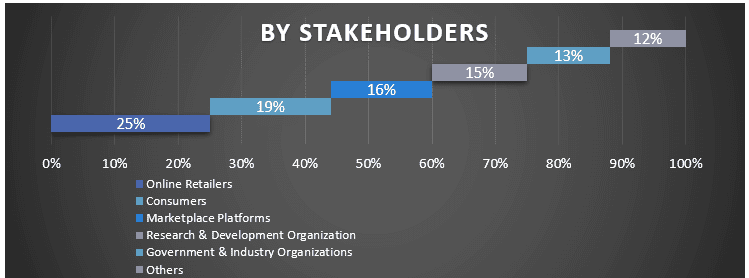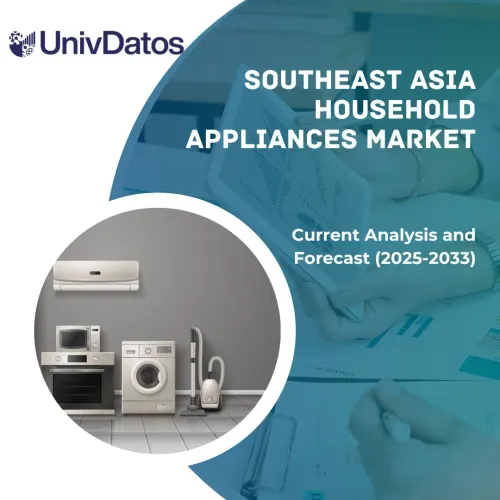- Home
- About Us
- Industry
- Services
- Reading
- Contact Us
MENA E-Commerce Market: Current Analysis and Forecast (2023-2030)
Emphasis on Product Type (Consumer Electronics, Apparel and Footwear, Food and Drinks, Beauty and Personal Care, Consumer Appliances, and Others); Model Type (Business to Consumer, and Business to Business); and Country

The MENA E-Commerce Market is expected to grow at a strong CAGR of 5.5% during the forecast period (2023-2030). The growing adoption of the MENA (Middle East and North Africa) ecommerce market has been a significant trend in recent years. With the increasing availability of internet access, digital payment solutions, and the proliferation of smartphones, consumers in the MENA region are embracing online shopping like never before. This shift is primarily driven by the convenience and wide variety of products and services offered by ecommerce platforms. Additionally, the COVID-19 pandemic has accelerated this adoption as it forced people to stay at home and rely more on online shopping for their needs. As a result, both local and international ecommerce players are actively tapping into the MENA market, providing a diverse range of products, attractive deals, and secure payment options to cater to the rapidly growing demand. This surge in ecommerce activity is not only benefiting consumers but also presenting immense opportunities for businesses to expand their reach and scale in the region. The UAE has the highest degree of digitalization, with 99% of the population having access to the internet. Saudi Arabia’s digitalization is at 90%, while Egypt offers 71% of its population access to the internet.
Some of the major players operating in ebay Inc., Noon., SHARAF DG LLC, LETSTANGO, Namshi., Amazon.com, Inc, Mumzworld, microless.com., EasyShopping.ae & Danube homes. Several M&As along with partnerships have been undertaken by these players to facilitate customers with hi-tech and innovative products/technologies.
Insights Presented in the Report
“Amongst model type, the Market is segmented into business to consumer and business to business. The business to consumer segment is expected to grow with a significant CAGR during the forecast period (2023-2030).”
Based on model type, the Market is segmented into business to consumer and business to business. With a population of over 400 million people and increasing internet penetration, MENA presents a vast and lucrative market for B2C businesses. The rise of technology and changing consumer behaviors have facilitated the growth of online shopping, with consumers increasingly opting for the convenience of purchasing products and services from the comfort of their homes. This shift has created ample opportunities for businesses to establish their online presence and tap into the MENA ecommerce market. As a result, the B2C segment in MENA is witnessing a surge in investments, innovation, and competition, offering exciting prospects for both local and international businesses.
MENA E-Commerce Market Report Coverage

“Saudi Arabia dominated the market.”
Saudi Arabia, the largest economy in the Gulf Cooperation Council (GCC), has also witnessed a remarkable growth in the e-commerce market. The government’s Vision 2030 program, which aims to diversify Saudi Arabia’s economy, has placed a strong emphasis on advancing the digital sector, including e-commerce. For instance, the country’s e-commerce market was supported by the establishment of an e-commerce law in 2020 to achieve the strategic objectives of the country’s Vision 2030 plan. The country has seen a surge in the number of online shoppers, with consumers increasingly attracted to the ease of online shopping, broader product selections, and competitive pricing. E-commerce giants and several start-ups have capitalized on this growing trend, fueling the expansion of the e-commerce market in Saudi Arabia.
Reasons to buy this report:
- The study includes market sizing and forecasting analysis validated by authenticated key industry experts.
- The report presents a quick review of overall industry performance at one glance.
- The report covers an in-depth analysis of prominent industry peers with a primary focus on key business financials, product portfolios, expansion strategies, and recent developments.
- Detailed examination of drivers, restraints, key trends, and opportunities prevailing in the industry.
- The study comprehensively covers the market across different segments.
- Deep dive regional level analysis of the industry.
Customization Options:
The MENA E-Commerce market can further be customized as per the requirement or any other market segment. Besides this, UMI understands that you may have your own business needs, hence feel free to connect with us to get a report that completely suits your requirements.
Table of Content
Research Methodology for the MENA E-Commerce Market Analysis (2023-2030)
Analyzing the historical market, estimating the current market, and forecasting the future market of the MENA e-commerce market were the three major steps undertaken to create and analyze the adoption of MENA e-commerce in major countries. Exhaustive secondary research was conducted to collect the historical market numbers and estimate the current market size. Secondly, to validate these insights, numerous findings and assumptions were taken into consideration. Moreover, exhaustive primary interviews were also conducted, with industry experts across the value chain of the MENA e-commerce market. Post assumption and validation of market numbers through primary interviews, we employed a top-down/bottom-up approach to forecasting the complete market size. Thereafter, market breakdown and data triangulation methods were adopted to estimate and analyze the market size of segments and sub-segments of the industry pertains to. Detailed methodology is explained below:
Analysis of Historical Market Size
Step 1: In-Depth Study of Secondary Sources:
Detail secondary study was conducted to obtain the historical market size of the MENA e-commerce market through company internal sources such as annual reports & financial statements, performance presentations, press releases, etc., and external sources including journals, news & articles, government publications, competitor publications, sector reports, third-party database, and other credible publications.
Step 2: Market Segmentation:
After obtaining the historical market size of the MENA e-commerce market, we conducted a detailed secondary analysis to gather historical market insights and share for different segments & sub-segments for major regions. Major segments are included in the report as model type and product type. Further country-level analyses were conducted to evaluate the overall adoption of testing models in that region.
Step 3: Factor Analysis:
After acquiring the historical market size of different segments and sub-segments, we conducted a detailed factor analysis to estimate the current market size of the MENA e-commerce market. Further, we conducted factor analysis using dependent and independent variables such as model type and product type of the MENA e-commerce market. A thorough analysis was conducted for demand and supply-side scenarios considering top partnerships, mergers and acquisitions, business expansion, and product launches in the MENA e-commerce market sector across the globe.
Current Market Size Estimate & Forecast
Current Market Sizing: Based on actionable insights from the above 3 steps, we arrived at the current market size, key players in the MENA e-commerce market, and market shares of the segments. All the required percentage shares split, and market breakdowns were determined using the above-mentioned secondary approach and were verified through primary interviews.
Estimation & Forecasting: For market estimation and forecast, weights were assigned to different factors including drivers & trends, restraints, and opportunities available for the stakeholders. After analyzing these factors, relevant forecasting techniques i.e., the top-down/bottom-up approach were applied to arrive at the market forecast for 2030 for different segments and sub-segments across the major markets. The research methodology adopted to estimate the market size encompasses:
- The industry’s market size, in terms of revenue (USD) and the adoption rate of the MENA e-commerce market across the major markets domestically
- All percentage shares, splits, and breakdowns of market segments and sub-segments
- Key players in the MENA e-commerce market in terms of products offered. Also, the growth strategies adopted by these players to compete in the fast-growing market
Market Size and Share Validation
Primary Research: In-depth interviews were conducted with the Key Opinion Leaders (KOLs) including Top Level Executives (CXO/VPs, Sales Head, Marketing Head, Operational Head, Regional Head, Country Head, etc.) across major regions. Primary research findings were then summarized, and statistical analysis was performed to prove the stated hypothesis. Inputs from primary research were consolidated with secondary findings, hence turning information into actionable insights.
Key Stakeholders of MENA E-Commerce Market in the MENA Region

Market Engineering
The data triangulation technique was employed to complete the overall market estimation and to arrive at precise statistical numbers for each segment and sub-segment of the MENA e-commerce market. The data was split into several segments & and sub-segments post studying various parameters and trends in the areas of the model type and product type of the MENA e-commerce market.
The main objective of the MENA e-commerce Market Study
The current & future market trends of the MENA e-commerce market were pinpointed in the study. Investors can gain strategic insights to base their discretion for investments on the qualitative and quantitative analysis performed in the study. Current and future market trends determined the overall attractiveness of the market at a regional and country level, providing a platform for the industrial participant to exploit the untapped market to benefit from a first-mover advantage. Other quantitative goals of the studies include:
- Analyze the current and forecast market size of the MENA e-commerce market in terms of value (USD). Also, analyze the current and forecast market size of different segments and sub-segments.
- Segments in the study include areas of the model type and product type.
- Define and analysis of the regulatory framework for the MENA e-commerce
- Analyze the value chain involved with the presence of various intermediaries, along with analyzing customer and competitor behaviors of the industry
- Analyze the current and forecast market size of the MENA e-commerce market for the major region
- Major countries of regions studied in the report include Saudi Arabia, UAE, Iran, Egypt, and Rest of MENA
- Company profiles of the MENA e-commerce market and the growth strategies adopted by the market players to sustain in the fast-growing market
- Deep dive regional level analysis of the industry
Related Reports
Customers who bought this item also bought










